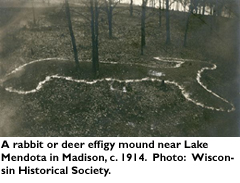A man-mound found in Sauk county, Wisconsin.
Effigy mounds reflect the ideas and ideology of ancient Native Americans about the nature of the natural world and how to live in it. Effigy mounds act as important symbols in Native American religion and spiritual views. These symbols, like other symbols in other religions fit into Geertz’s definition of religion. These symbols “establish powerful, pervasive moods and motivations in men.” These mounds act as symbols that seek to promote balance and harmony in the world in the ancient Native American belief system. The mounds dually act as a motivation for the people to maintain balance and harmony with the earth and also by making the mounds Native Americans may have believed that they were participating in restoring harmony to the world. In a time when social and economic changes were taking place Native Americans sought to keep in balance and harmony with the earth. They believed they could do this through use of symbols such as effigy mounds. When building groups of effigy mounds they almost always have mounds representing both the upper and lower worlds, to maintain balance.
The effigy mounds formulate conceptions of a general order of existence by emphasizing the importance of the natural world in their daily lives and also dividing their world into two main divisions. For the Native Americans who built these mounds, living off the land was how they survived. The placement of the mounds and rituals that took place around the mounds emphasize renewal and rebirth which would be important for these particular groups since they seem to have survived off of agriculture and hunting, both of which depend on the availability and abundance of animals and crops. Through the images depicted by the mounds, the world (both natural and supernatural) is divided into three categories which include elements of the air (or upperworld), elements of the earth and elements of the water (or lowerworld), distinctly represented in effigy mound construction through use of animal forms and other shapes that pertain to each division. Air is often represented by mounds in the shape of birds and raptors, earth is often signified by land animals such as bears and bison, water is often represented by water spirits, often depicted as long-tailed creatures. The mounds were the symbols that were a big part of unknown rituals and ceremonies that were important in the religious views of early Native Americans. Where the different types of effigy mounds are located are often related to the division the mound belongs to. Bird effigies might be found on a hillside whereas water spirit effigy mounds may be found near a spring of water. The placement and content of the mounds are directly related to the conception of the order of existence formulated by this group of people, with things of the upperworld seen as being more important and higher up in social status whereas the things of the lower world were sometimes seen as being bad or lower on the social scale.


I like your point about the native cultures trying to maintain balance and harmony in the world around them. I think its interesting that they worked with nature to find balance instead trying to destroy it or over come it like modern culture seems to embrace. The mounds themselves are interesting because like you said they "emphasize the importance of the natural world" while still modifying the natural world. I think it's interesting that the native culture was able to find a way to shape the natural world around them while still keeping it orderly and "natural". It seems today that when we try to modify the natural world things end up getting destroyed.
ReplyDelete